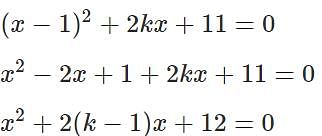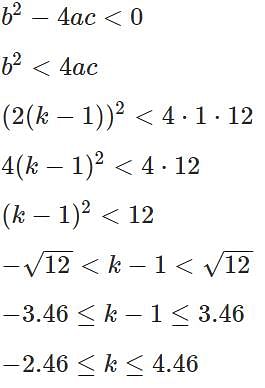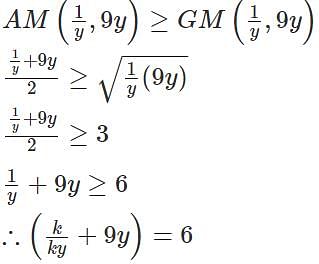CAT Exam > CAT Questions > Let kbe the largest integer such that the equ...
Start Learning for Free
Let k be the largest integer such that the equation (x−1)2 + 2kx + 11 = 0 has no real roots. If y is a positive real number, then the least possible value of k/4y + 9y is
Correct answer is '6'. Can you explain this answer?
| FREE This question is part of | Download PDF Attempt this Test |
Most Upvoted Answer
Let kbe the largest integer such that the equation(x−1)2 + 2kx +...

Since the equation above has no real roots, the discriminant of the equation should be negative.

The largest integral value that k can take is 4.
Now, we need to minimize k/4y + 9y where k takes the largest integral value and y is positive…

1/y & 9y are both positive real numbers, therefore, their A.M is greater than equal to their G.M.

Free Test
FREE
| Start Free Test |
Community Answer
Let kbe the largest integer such that the equation(x−1)2 + 2kx +...
Explanation:
Finding the value of k:
- Given equation: (x-1)^2 + 2kx + 11 = 0
- For no real roots, discriminant < />
- Discriminant = 4k^2 - 4(11-(1)^2) < />
- 4k^2 - 40 < />
- k^2 < />
- k = 3 (largest integer)
Finding the least possible value of k/4y + 9y:
- Given y is a positive real number
- k = 3, y > 0
- k/4y + 9y = 3/(4y) + 9y
- To minimize the value, make the first term as small as possible
- Minimize 3/(4y) by maximizing y
- Let y = 1/4, then 3/(4y) = 3
- Substitute y = 1/4 in the expression k/4y + 9y
- 3/1 + 9(1/4) = 3 + 9/4 = 12/4 + 9/4 = 21/4 = 5.25
Therefore, the least possible value of k/4y + 9y is 5.25, not 6.
Finding the value of k:
- Given equation: (x-1)^2 + 2kx + 11 = 0
- For no real roots, discriminant < />
- Discriminant = 4k^2 - 4(11-(1)^2) < />
- 4k^2 - 40 < />
- k^2 < />
- k = 3 (largest integer)
Finding the least possible value of k/4y + 9y:
- Given y is a positive real number
- k = 3, y > 0
- k/4y + 9y = 3/(4y) + 9y
- To minimize the value, make the first term as small as possible
- Minimize 3/(4y) by maximizing y
- Let y = 1/4, then 3/(4y) = 3
- Substitute y = 1/4 in the expression k/4y + 9y
- 3/1 + 9(1/4) = 3 + 9/4 = 12/4 + 9/4 = 21/4 = 5.25
Therefore, the least possible value of k/4y + 9y is 5.25, not 6.
Attention CAT Students!
To make sure you are not studying endlessly, EduRev has designed CAT study material, with Structured Courses, Videos, & Test Series. Plus get personalized analysis, doubt solving and improvement plans to achieve a great score in CAT.

|
Explore Courses for CAT exam
|

|
Similar CAT Doubts
Let kbe the largest integer such that the equation(x−1)2 + 2kx + 11 = 0has no real roots. If y is a positive real number,then the least possible value of k/4y + 9y isCorrect answer is '6'. Can you explain this answer?
Question Description
Let kbe the largest integer such that the equation(x−1)2 + 2kx + 11 = 0has no real roots. If y is a positive real number,then the least possible value of k/4y + 9y isCorrect answer is '6'. Can you explain this answer? for CAT 2024 is part of CAT preparation. The Question and answers have been prepared according to the CAT exam syllabus. Information about Let kbe the largest integer such that the equation(x−1)2 + 2kx + 11 = 0has no real roots. If y is a positive real number,then the least possible value of k/4y + 9y isCorrect answer is '6'. Can you explain this answer? covers all topics & solutions for CAT 2024 Exam. Find important definitions, questions, meanings, examples, exercises and tests below for Let kbe the largest integer such that the equation(x−1)2 + 2kx + 11 = 0has no real roots. If y is a positive real number,then the least possible value of k/4y + 9y isCorrect answer is '6'. Can you explain this answer?.
Let kbe the largest integer such that the equation(x−1)2 + 2kx + 11 = 0has no real roots. If y is a positive real number,then the least possible value of k/4y + 9y isCorrect answer is '6'. Can you explain this answer? for CAT 2024 is part of CAT preparation. The Question and answers have been prepared according to the CAT exam syllabus. Information about Let kbe the largest integer such that the equation(x−1)2 + 2kx + 11 = 0has no real roots. If y is a positive real number,then the least possible value of k/4y + 9y isCorrect answer is '6'. Can you explain this answer? covers all topics & solutions for CAT 2024 Exam. Find important definitions, questions, meanings, examples, exercises and tests below for Let kbe the largest integer such that the equation(x−1)2 + 2kx + 11 = 0has no real roots. If y is a positive real number,then the least possible value of k/4y + 9y isCorrect answer is '6'. Can you explain this answer?.
Solutions for Let kbe the largest integer such that the equation(x−1)2 + 2kx + 11 = 0has no real roots. If y is a positive real number,then the least possible value of k/4y + 9y isCorrect answer is '6'. Can you explain this answer? in English & in Hindi are available as part of our courses for CAT.
Download more important topics, notes, lectures and mock test series for CAT Exam by signing up for free.
Here you can find the meaning of Let kbe the largest integer such that the equation(x−1)2 + 2kx + 11 = 0has no real roots. If y is a positive real number,then the least possible value of k/4y + 9y isCorrect answer is '6'. Can you explain this answer? defined & explained in the simplest way possible. Besides giving the explanation of
Let kbe the largest integer such that the equation(x−1)2 + 2kx + 11 = 0has no real roots. If y is a positive real number,then the least possible value of k/4y + 9y isCorrect answer is '6'. Can you explain this answer?, a detailed solution for Let kbe the largest integer such that the equation(x−1)2 + 2kx + 11 = 0has no real roots. If y is a positive real number,then the least possible value of k/4y + 9y isCorrect answer is '6'. Can you explain this answer? has been provided alongside types of Let kbe the largest integer such that the equation(x−1)2 + 2kx + 11 = 0has no real roots. If y is a positive real number,then the least possible value of k/4y + 9y isCorrect answer is '6'. Can you explain this answer? theory, EduRev gives you an
ample number of questions to practice Let kbe the largest integer such that the equation(x−1)2 + 2kx + 11 = 0has no real roots. If y is a positive real number,then the least possible value of k/4y + 9y isCorrect answer is '6'. Can you explain this answer? tests, examples and also practice CAT tests.

|
Explore Courses for CAT exam
|

|
Suggested Free Tests
Signup for Free!
Signup to see your scores go up within 7 days! Learn & Practice with 1000+ FREE Notes, Videos & Tests.
























